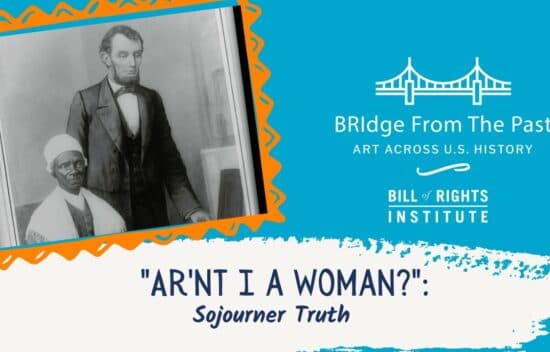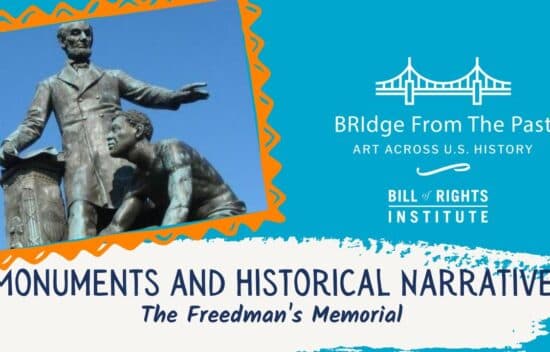



BRIdge from the Past | Black History Resources
12 items

“Ar’nt I a Woman?” Sojourner Truth and the Abolitionist Movement | BRIdge from the Past
Video
Video
10 Min
How can images help us understand the role of African American women in the abolitionist movement? In this episode, Mary explores an image of Sojourner Truth. Born into slavery in New York, she dedicated her life to abolition and equal rights for women and men. How did her famous "Ar'nt I a Woman?" speech convey her life-long commitment to the ideals of liberty and equality?
*The source we reviewed used the phrase "Ar'nt I a Woman?" but Sojourner Truth's speech is often also titled "Ain't I a Woman?"
10 Min

Paths to Freedom: African Americans and the American Revolution | BRIdge from the Past
Video
Video
9 Min
Images can help tell the story of major events throughout U.S. History, but sometimes, you must look closely to uncover the hidden stories from the past. In this episode of BRIdge From The Past, Mary explores famous paintings depicting the role of African Americans during the American Revolution. How are African Americans depicted in paintings from this period? What clues are we still missing from their role in the Revolutionary War?
9 Min

Portrait Stories: African Americans and the Founding Era | BRIdge from the Past
Video
Video
11 Min
What can portraits reveal about African Americans during the Founding Era? In this week's BRIdge from the Past, Mary explores what a miniature portrait of Elizabeth "Mumbet" Freeman, a formerly enslaved woman turned paid domestic servant, can tell us about her life and the lives of other African Americans during this time.
11 Min

Portrait Stories: African Americans and the Founding Era *Part 2* | BRIdge from the Past
Video
Video
9 Min
What can portraits reveal about African Americans during the Founding Era? In her second episode exploring African Americans and the Founding Era, Mary looks at a woodcut portrait of Benjamin Banneker, a self-taught African American author and thinker born in 1731. What is the significance of the inclusion of this portrait in Banneker's own published almanac? What did Banneker's publishing of almanacs have to do with the fight against–in Banneker's own words–“the almost general prejudice and prepossession which is so prevalent in the world against those of my complexion”?
9 Min

Illustrations from Uncle Tom’s Cabin | BRIdge from the Past
Video
Video
11 Min
What was the role of Uncle Tom’s Cabin in advancing the anti-slavery cause? In this episode of BRIdge from the Past, Mary explores illustrations from the famous novel. Has the novel’s legacy changed over time and how should we remember it today?
11 Min

Slavery at Mount Vernon: Grappling with Our Founding’s Complex Story | BRIdge from the Past
Video
Video
15 Min
How can we talk about founding principles of liberty and equality without accounting for slavery? To explore this question, Mary went to George Washington’s Mount Vernon just outside of Washington, DC, and spoke with Director of Interpretation, Jeremy Ray. What does the design of the Greenhouse Slave Quarters reveal about the two sides of the plantation: the ornamental, public-facing greenhouse side and the functional, behind-the-scenes side where the people held in bondage lived? How can visiting historical places like Mount Vernon help us grapple with our complex story?
15 Min

Reconstruction & African American Education | BRIdge from the Past: Art Across U.S. History
Video
Video
10 Min
How did African Americans experience education during Reconstruction? In this episode of BRIdge from the Past, Mary explores the images of Fisk Jubilee Hall and the Fisk Jubilee Singers to understand the lengths formally enslaved individuals went in order to establish educational facilities and the resistance they faced. What do these images reveal about the African American experience during the time period? How can we use these images to understand the importance of education today?
10 Min

Thomas Nast on Reconstruction | BRIdge from the Past: Art Across U.S. History
Video
Video
17 Min
What impact did the Reconstruction Amendments have on the application of our Founding principles? In this video, Mary and Gary explore two Reconstruction-era cartoons by Thomas Nast. “Uncle Sam’s Thanksgiving Dinner" (1869) and “The Union As It Was" (1874) give insight into the nature of liberty and equality in the United States shortly after the Civil War. Do you agree with Nast’s commentary about the intentions and consequences of Reconstruction?
17 Min

Protest and Calling for Change: Images of the Silent Parade | BRIdge from the Past
Video
Video
10 Min
What was the “Silent Parade”? In this episode of BRIdge from the Past, Mary examines images of a 1917 silent march down Fifth Avenue in New York City to understand why 10,000 African Americans participated. What events precipitated this march? How do these images compare with those of other historical events or protests where Americans have called for change?
10 Min

When Did the Civil Rights Movement Begin? Reconstruction & the Civil Rights Act of 1875
Video
Video
11 Min
Today, Mary looks at an image from the Reconstruction era that challenges us to reconsider what we mean when we say “the civil rights movement.” Typically, if someone says, "Civil Rights Movement," we think of the 1950s and 1960s, but does the story go back further? Similarly, if someone mentions “the civil rights act” we think of the landmark legislation in the Civil Rights Act of 1964. But this isn’t the only civil rights act to date nor is it the first.
Explore the 13th Amendment, 14th Amendment, and 15th Amendment (Reconstruction Amendments), the Civil Rights Act of 1875, and other primary sources surrounding the era or reconstruction and the continuous work to achieve civil rights for black Americans.
11 Min

Monuments and Historical Narratives: The Freedman’s Memorial | BRIdge from the Past
Video
Video
11 Min
How can historical narratives help us understand statutes and memorials? In a special episode, Liz fills in for Mary to explore the Emancipation Memorial, also known as the Freedman's Memorial, in Washington, DC. After Lincoln's assassination, a group of formerly enslaved individuals raised money for this statue to honor Abraham Lincoln. How did this sculpture fit into the greater story of African American rights during Reconstruction?
11 Min

Art in the Harlem Renaissance: Jacob Lawrence’s The Migration Series | BRIdge from the Past
Video
Video
10 Min
Mary explores "The Migration Series" by Jacob Lawrence, a vivid depiction of everyday life for African Americans during their migration north amidst World War I. She analyzes select images to understand the social and economic factors behind this movement and what happened when they arrived in the north. What signs of hope and perseverance are conveyed in these images?
10 Min